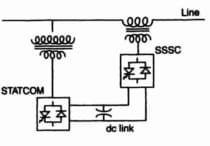1. UPFC stands for___________.
a. Unified power flow controller
b. Unidentified power flow controller
c. Unijunction power flow controller
d. None of these
2. The Unified Power Flow Controller (UPFC) concept was proposed by_________.
a. Gyugyi
b. Hingorani
c. Ravichandrudu
d. Smith
3. The UPFC concept was proposed in the year__________.
a. 1988
b. 1991
c. 1993
d. 1996
4. The UPFC was devised for the ________.
a. Future-time
b. Real-time
c. Past-time
d. None of above
5. The UPFC is able to control all the parameters___________.
a. Simultaneously
b. Selectively
c. Not possible
d. Both a & b
6. The UPFC can control_________.
a. Voltage
b. Impedance
c. Phase angle
d. All the above
7. UPFC can independently control both the _________ and _________ power flow in the line.
a. Real, Reactive
b. Real, Apparent
c. Reactive, Apparent
d. None of these
8. SVS generally exchanges both _______ and _______ power with the transmission system.
a. Real, Apparent
b. Reactive, Apparent
c. Reactive, Real
d. None of these
9. SVS stands for__________.
a. Single virtual system
b. Synchronous voltage source
c. Synchronous vision system
d. None of these
10. The UPFC consists of ________ voltage-sourced converters.
a. One
b. Two
c. Three
d. Four
11. UPFC can control__________.
a. Active
b. Reactive
c. Both a & b
d. Only b
12. UPFC is a combination of __________ and __________ converter coupled via common voltage DC link.
a. SVC, STATCOM
b. Series, Series
c. STATCOM, SSSC
d. None of these
13. The UPFC uses a combination of shunt controller and a series controller interconnected through a common DC bus_______.
a. True
b. False
c. Partially
d. None of these
14. The ____________, by means of angularly unconstrained series voltage injection is able to control selectively the transmission line voltage, impedance, and phase angle or alternatively the active and reactive power.
a. SSSC
b. UPFC
c. TCSC
d. None of the above
15. UPFC is a combination of which controller_________.
a. STATCOM and SSSC
b. Series and Shunt
c. TCSC-TCR
d. Both a & b
16. UPFC allows_____________ real power between SSSC and STATCOM
a. Unidirectional
b. Bidirectional
c. Separately operated
d. None of these
17. UPFC is a combination of _____________.
a. Static synchronous compensator
b. Static series compensator
c. None of these
d. Both a & b
18. In UPFC the active power for the series unit is obtained from the line itself via the_______ unit.
a. Series
b. Shunt
c. Both a & b
d. None of these
19. The controlled exchange of real power with an external source, such as _________, is much more effective in control of system dynamics than modulation of the power transfer within a system.
a. Storage
b. Line
c. Transformer
d. None of these
20. Which diagram shows the UPFC ___________.
a.
b.c.
d.
21. Control attributes of UPFC are___________.
a. Active and reactive power control
b. Voltage control
c. VAR compensation
d. All the above
22. Which is the Control attributes of UPFC _________.
a. Damping oscillations
b. Voltage stability
c. Fault current limiting
d. All the above
23. Which device is a combination of series and shunt compensator_________.
a. TCSC
b. SSSC
c. UPFC
d. IPFC
24. The _________ can function as a perfect Phase angle Regulator which can also supply the reactive power involved with the transmission angle control by internal var generation.
a. STATCOM
b. SSSC
c. UPFC
d. None of these
25. The basic function of ___________ is to supply or absorb the real power demanded by __________ at the common dc link to support the real power exchange.
a. Converter 1, Converter 2
b. Converter 2, Converter 1
c. Converter 1, Converter 1
d. Converter 2, Converter 2









0 Comments
If you have any doubt, feel free to ask.